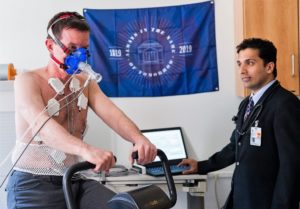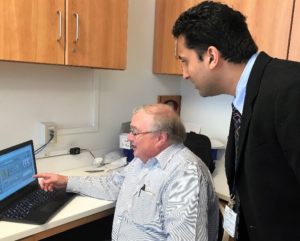
With Exercise Physiology Core Lab staff at UVA
An essential duty of a hospital medicine provider is to pick up the earliest signs of clinical deterioration. This is crucial because delays in initiation of therapy often have disastrous consequences in the acutely ill patients that are seen by hospitalists. Dr. Shrirang Gadrey’s research aims to use the power of advanced sensing and signal processing technology to create novel solutions for commonly encountered problems in hospital medicine.
One area of his study has been the use of oxygen-hemoglobin dissociation curve (ODC) models to estimate the partial pressure of arterial oxygen (PaO2) using non-invasive pulse oximetry sensors (SpO2) instead of invasive arterial blood sampling. He found that all existing models have a very concerning bias towards underestimating the degree of respiratory failure. So, he created a distinct model of the ODC that provides more accurate and unbiased PaO2 estimates. This model is much better suited for use in acutely ill patients than all prior models.

Pilot testing a novel respiratory kinematics monitoring device in UVA’s exercise physiology lab

Studying respiratory kinematic signals with Dr Williams
Another exciting area of his work involves collaboration with Dr. Ronald Williams in the School of Engineering. This work is funded by a seed grant from UVA’s Center for Engineering in Medicine. Together, Dr. Gadrey and Dr. Williams have created a novel diagnostic device. This device analyzes complex patterns of respiratory kinematics (the breath related motion of the thorax and abdomen) to predict clinical deterioration. Currently, this device is being tested in healthy subjects in the exercise physiology lab, and preliminary results are encouraging.
Shrirang Gadrey presenting the new model for the oxygen-hemoglobin dissociation curve at the Society of Hospital Medicine’s annual meeting in 2019.
Filed Under: In the Know
